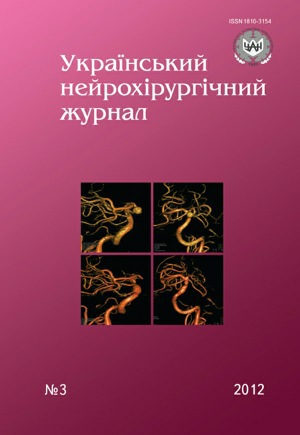Effect of postoperative multiple organ failure on early mortality after the surgical treatment of hemorrhagic strokes
DOI:
https://doi.org/10.25305/unj.60841Keywords:
hemorragic stroke, lethality, cerebral and extracerebral factors, systemic inflammatory response syndrome, organs’ dysfunction, multiple organ dysfunction syndromeAbstract
Introduction. Intracranial hemorrhages make from 10 to 15% of cerebrovascular accidents (CVA). Lethality at conservative treatment in first 30 days reaches 35%. Today surgical methods of treatment are used, that often are accompanied by multiple organ dysfunction syndrome (MODS). These data were not described in literature.
Materials and methods. 224 patients after hemorrhagic stroke surgical treatment were examined, 119 of them are alive, 105 — died. In the early postoperative period SOFA scale was used for MODS severity estimation, and R. Bone criteria — for SIRS.
Results. Even at short-time deterioration of the patients’ state (3 points on SOFA scale and more) the lethality increased. At the dead indicators of heart rate (HR), respiration rate (RR), body’s temperature corresponded to SIRS, indicators of Glasgow Coma Scale (GCS), PaO2/FiO2, average blood pressure were in a stage of the expressed insufficiency. At the survived the above-mentioned SIRS indicators were normal, MODS indicators — in a stage of dysfunction. The difference between MODS and SIRS indicators at dead and survived patients increased significantly in the early postoperative period. Lethality predictors that were revealed 5–10 times more often at unfavorable prognosis and were reliable (P<0.001) were considered as cerebral (GCS 9 points and less), respiratory (PaO2/FiO2 200 and less), heart (average BP less than 70 mm Hg, dopamine infusion more than 5 mcg´kg-1´h-1), renal (creatine 300 mg/L and more) insufficiency and score on SOFA scale more than 10. A lethality was significantly influenced by SIRS indicators (HR, RR, body’s temperature).
References
1. Zozulya YU, Voloshyn PV, Mishchenko TS. Suchasni pryntsypy diahnostyky ta likuvannya khvorykh iz hostrymy porushennyamy mozkovoho krovoobihu: metod. Rekomendatsiyi [Modern principles of diagnosis and treatment of patients with acute stroke:Guidelines]. Kiev; 2005. Ukrainian.
2. Liebeskind D, Kirshner H, Nassisi D, Saver J. Hemorrhagic stroke in emergency medicine. [Internet]. Medscape reference; [cited 2015 Joinery 8] Available at: http://emedicine.medscape.com/article/1916662-overview#showall
3. Maltseva LA, Usenko L V, Kobelyatskiy YU YU, editors. Neyroreanimatologiya [Intensive care in neurology]. Dnepropetrovsk: ART-PRESS; 2008. Russian.
4. Ishizaki T, Imanaka Y, Sekimoto M, Fukuda H, Mihara H. Comparisons of risk-adjusted clinical outcomes for patients with aneurysmal subarachnoid haemorrhage across eight teaching hospitals in Japan. J Eval Clin Pract. 2008;14(3):416-421. [CrossRef] [PubMed]
5. Abbaszade EZ. Vnutrishn`omozkovi i vnutrishn`oshlunochkovi krovovylyvy v rezul`tati rozryvu anevryzm peredn`oho pivkil`tsya arterial`noho kola holovnoho mozku (klinika, diahnostyka, likuvannya). [Intracerebral and intraventricular hemorrhages in result of aneurysms rupture of the anterior half-ring of arterial cirle of the brain (clinic, diagnosis, treatment)]. [dissertation]. Kiev (Ukraine): Romodanov Neurosurgery Institute; 2011. Ukrainian.
6. Novozhilova MA. Prognoz rannikh iskhodov u bolnykh s gemorragicheskimi insultami. [dissertation]. St. Petersburg (Russia); 2010. Russian.
7. Zygun D, Doig C, Gupta A et al. Non-neurological organ dysfunction in neurocritical care. Journal of Critical Care. 2003;18(4):238-244. [CrossRef]
8. Sizov DN, Kostyuchenko AL, Belskikh AN. [Multiple organ failure syndrome in critically ill patients] Anesteziol Reanimatol. 1998 ;2:22–25. Russian. [PubMed]
9. Rudnov VA. Ot lokalnogo vospaleniya k sistemnomu: vykhod na novyye predstavleniya patogeneza kriticheskikh sostoyaniy i perspektivy terapii. [Internet]. Zhurn. Intensiv. terapiya. Russian. Available at: http://www.icjcorp.ru/2006-01-01.html
10. Cherniy VI, Nesterenko AN. Narusheniya immuniteta pri kriticheskikh sostoyaniyakh: osobennosti diagnostiki. Vnutr. meditsina. 2007;2–4:12–22. Russian. http://www.mif-ua.com/archive/article/414
11. Royt A, Brestofor Dzh, Meyl. Immunologiya [Immunology]. Moscow: Mir; 2000. Russian.
12. Baue A, Faist E, Fry D. Multiple organ failure: Pathophysiology, prevention and therapy. N.Y.: Springer–Verlag; 2000. [CrossRef]
Downloads
Published
How to Cite
Issue
Section
License
Copyright (c) 2012 Olga Kamenska, Leonard Chepkiy, Orest Tsimeyko, Volodymyr Moroz

This work is licensed under a Creative Commons Attribution 4.0 International License.
Ukrainian Neurosurgical Journal abides by the CREATIVE COMMONS copyright rights and permissions for open access journals.
Authors, who are published in this Journal, agree to the following conditions:
1. The authors reserve the right to authorship of the work and pass the first publication right of this work to the Journal under the terms of Creative Commons Attribution License, which allows others to freely distribute the published research with the obligatory reference to the authors of the original work and the first publication of the work in this Journal.
2. The authors have the right to conclude separate supplement agreements that relate to non-exclusive work distribution in the form of which it has been published by the Journal (for example, to upload the work to the online storage of the Journal or publish it as part of a monograph), provided that the reference to the first publication of the work in this Journal is included.









